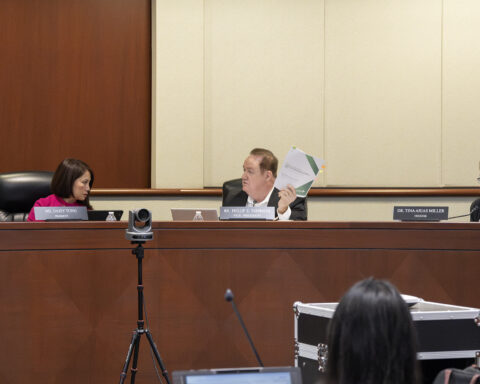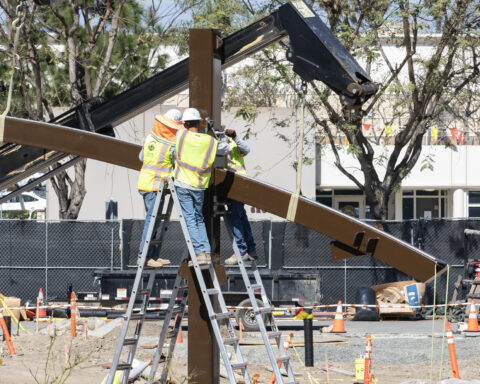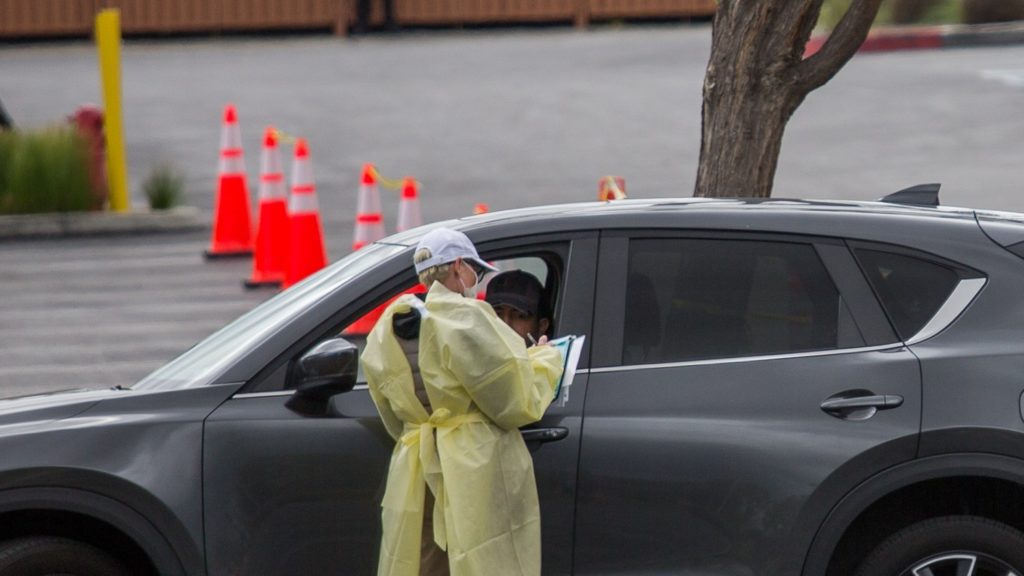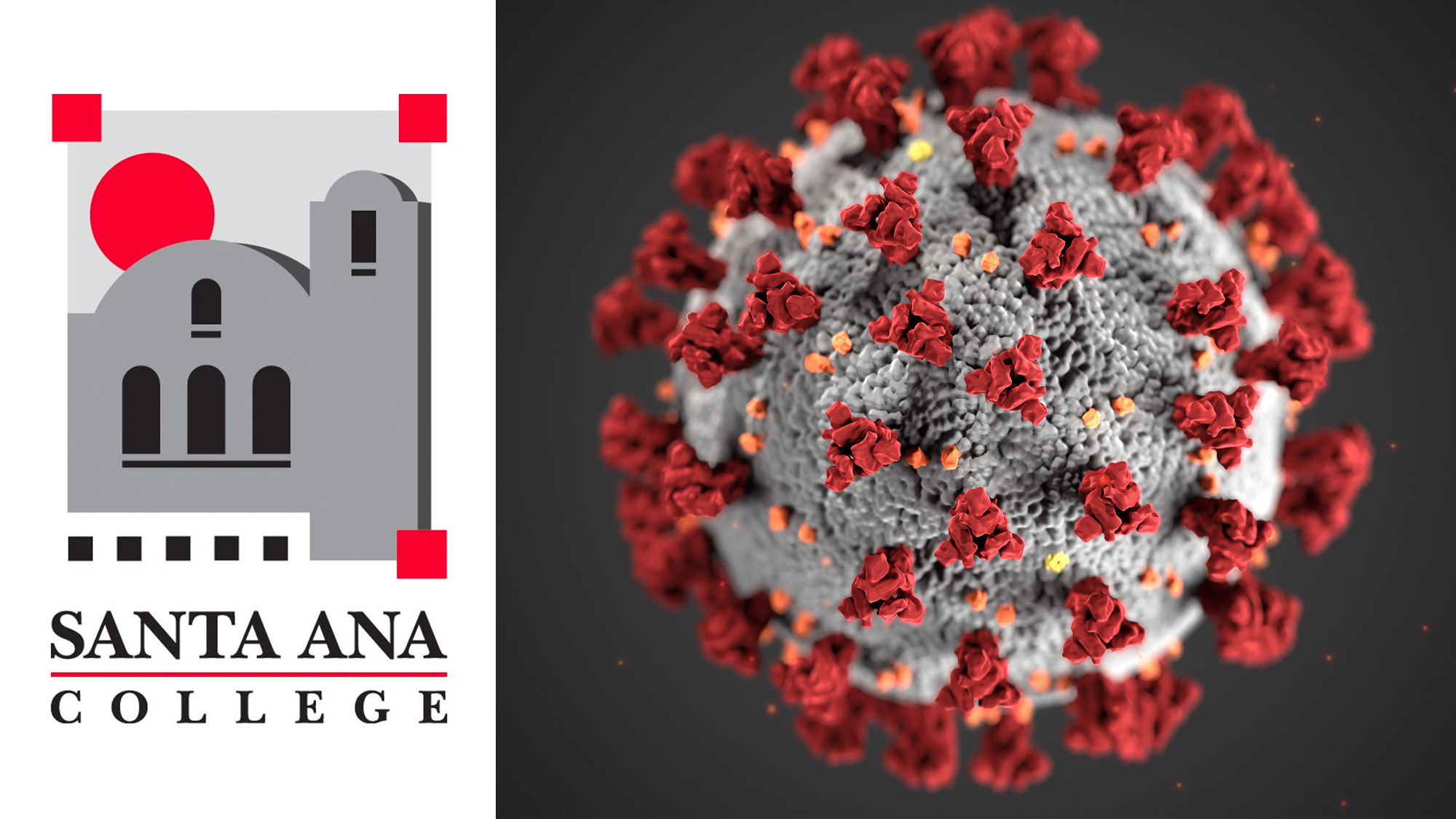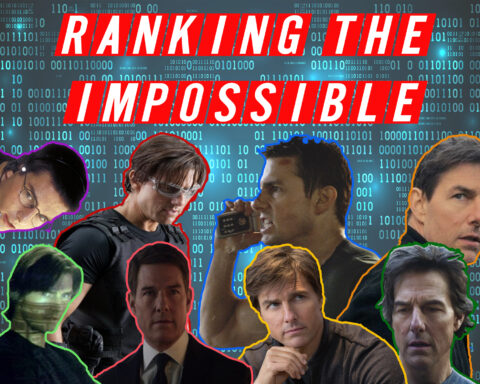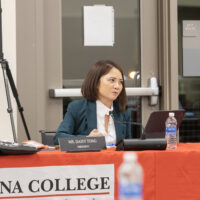Before we get started, do you have any announcements that you would like to share to everyone right now?
Yeah, I think the first one is that on May 11 everyone should be getting their refunds back for parking fees, both at SAC and SCC. And again, when you get that refund, it won’t be the full refund because we were in classes until March 12. So, prorated from the 13th to obviously the end of the semester. Just to be specific, what that means is you’ll get 65% of what you put in to pay for that refund back. In other words, if you pay $30, 65% comes out to a little bit under $20 of what you’ll get back. So we prorated on the basis of the time that you were here. And of course, and as you know, we began to close the beginning on the 13th of March. Everyone will get those checks. Very soon. My understanding is the way you’re going to be refunded, it’ll be like a debit card that you’re going to get that you could use. In order to spend that $19-$20. Also, the colleges, as it relates to the CARES act, this is the federal stimulus that we received from the federal government, that $2.3 trillion. No, we didn’t get $2.3 trillion. Just want to make sure that everybody knows that. Altogether, we got, if you combine what both SAC and SCC received, we got back $8.4 million. The legislation specifically stated that half of that is to go out to students as federal grants. Colleges are working and I think they’re supposed to be releasing it towards the latter part of next week and send out the grants to students at both campuses. Grants, to my understanding, will be arranged from anywhere from $300 to $500. Not a lot, but it’s something. And so wanted to let all the students know that the that’s also getting ready to be released and they’ll go out, those checks from the CARES act, towards the end of next week.
Have our dual-enrolled students been affected by going fully online?
They have not. We still have been offering those classes online to students who are in dual enrollment. As you know, the classes that students take in dual enrollment are classes. All of our classes have been moved into remote instruction and they’ve been able to enroll. Probably the challenges that the high school students face is one of: Do you have laptops at home? Do you have access to the Internet? And I know that they’ve been working with Santa Ana Unified in order to make sure the students get those laptops or, Santa Ana Unified, we loan our laptops to them. And so that’s been the that’s been probably the biggest challenge. But all those classes that were offered to dual enrollment did move into temporary remote instruction. As well as all the other classes that we have on our campuses.
Regarding the dual role students and the incoming freshmen, I know that a big part of getting the college experience includes being in a college classroom and engaging with other students from different high schools; that experience that most students already had before switching to temporary remote instruction. What plans are in the works to help incoming students have a first-year college experience?
Well, you know, we are working with students to still give them that first experience. Obviously, it’s all been done online and virtually. As you know, we’re having discussions now as to how we want to be able to offer the fall semester. What I can tell you is that we’re following the guidelines that the Governor has established. We’re not following the guidelines of the county.
The county, as you know, is superseded by the governor. An example of that is: the county made a decision to open up their beaches. As you know, the city council in Newport Beach a couple days ago voted to open up their beaches and so did Huntington Beach. The governor just came out and said, ‘Nope. We’re going to close the beaches.’ He’s in charge here. Who’s in charge is the governor. We will follow what the governor is going to outline, which he has done that in a lot of detail. A couple days ago he identified the four stages that he wants everyone to follow. And though all of us are on stage one, which is, stage one is the stage of preparedness and to make sure that we’re ready. We’re waiting for the governor to do one of two major things. One is: when does he want to lift the stay at home order? And he actually has said he’s not going to do that until since certain indicators have been followed. Such as, is there a downward trend, are we flattening the curve? Are there less hospitalizations? Are there less deaths? There’s some of those major indicators that he’s asking for before he can say, ‘You know what? We’re ready to open up.’ But he has also stated that even when he makes a decision to lift the order, it’s not going to be fully lifted. In other words, there’ll still be a limited opening. It’s not going to be everyone coming back face to face, like the way we were on March 12. Again, we’re waiting for the governor because though he will, in many ways, tell us what’s going to happen. The plans that we’re putting together are on the basis of what we know today. It’s hard to project what’s going to happen a month from now, two months from now. So what we know today is that we were going to open up largely remote instruction distance learning. There will be a few courses, really small, limited number of courses that could be offered on the campuses, face to face, and these are courses that we don’t have the technology to be able to offer them virtually. Some of those courses happened to be like the bio labs, the chem labs, some of the CTE courses. Again, it’s not going to be 100 courses or anything like that that we’re going to be offering face to face. A very small limited number. And when we do that on the campuses, we’ll be following all the strict guidelines that the governor wants us to follow, making sure there’s social distancing in those classrooms, making sure the students and faculty have facemasks, possibly gloves. Making sure that after each class is finished, that the custodial staff can come in, clean the classroom, sanitize them, disinfect them and get that classroom ready for another class that could happen that day. We could get the governor, maybe for example July 1, come out and say, ‘You know what? Everything’s great. Everything has improved. Let’s go back to much more face to face.’ Then if that happens, we’ll need to re-modify the plan. We’re going to do that so we could again try to accommodate the guidelines as much as possible. So that’s where we are today.
Dr. Lamb commented about the pass/no pass decision taken. He said that the option for students to switch their grades to pass no pass has been extended to July 25, but the consequences remain the same. What is the best advice you can give to those students who are deciding to switch to pass/no pass grading? Are we in any discussions with like the UCS over this policy?
I think the first thing to do is if your intent is to transfer to a University California campus or Cal State campus, make sure that that campus will accept a class that’s pass/no pass. If they don’t, obviously don’t take it. Take the class on the grading scale so that class can transfer and you could be given credit and you can transfer to the university of your choice. The best advice I would give students is at least look at whether those universities will accept that class. We are in communication with them as a system. And we’re also having those same discussions because we don’t want to convert classes to pass/no pass if the UC’s or CSU is not going to accept that. That’s not what we want. We want to be able to make sure that we are in cohesion with them and that if they’re going to support a class that has pass/no pass and we want to be able to get that from them in writing so that the students know that if they take that class, they’ll be given credit for it. All these things are happening so fast, Lesly. All of us are doing all these things remotely just like we’re meeting today and trying to make some of these major decisions. But it is a major one but again: the advice I would give students is continue to check or communicate with your counselors on the campuses, our campuses, whether SAC or SCC and ask them that question.
And also communicate with the universities and also ask them the same question to see if this class is going to be approved and supported by UC Irvine, if I’m transferring to UC Irvine, or Cal State Fullerton, if I’m going there. So, make sure that double check that.
I’ve been getting like reports about students not being fully present during their classes. For example, they’re going in the classroom, but they’re turning off their cameras and audio. Sometimes they’re doing other things, some of our students are parents, some of our students have to take care of family members and sometimes they can’t be fully there. But there’s still tuning in to the class. As we move forward with these online classes and improve, what is the district doing in order to ensure that students are present and participating and not just tuning in? Have you asked professors what methods they are taking?
We’re not like a high school where they’re taking attendance all the time. Obviously, if a student is not showing up to class, I’m sure that the instructor will send an email to that students to find out what’s going on, what’s the problem and they are doing it. They are checking in on students who are not coming to the classes virtually and asking them, ‘Well, how come you’re not participating?’ Is it an issue of you don’t have a laptop or you don’t have great internet? Is it an issue doing this class remotely? Is [it] not working for you? So, yeah. It’s the side that is happening, students are making contact. Obviously other faculty members, they don’t feel that it’s their responsibility to take attendance, because that’s not again, we’re not like a high school where attendance is taken. We rely upon the students taking on the responsibility and coming to the classes so they can learn what’s going on so they can eventually pass that class. It all depends on that faculty member, but what’s interesting is that when you asked me that question, there was a survey conducted over at SCC in regards to remote instruction and it was a really good survey. They surveyed 1600 students, so we got a lot of good feedback. A lot of them responded as to the challenges that they face with remote instruction. A lot of them said, you know, we’re talking about 80%, almost 90% of them were saying, ‘I do have a laptop. I’m good there. I do have access to good quality internet. I’m good there. I’m not crazy about remote instruction. I prefer face to face. I feel that I learned better face to face as to remote instruction.’ Others said, ‘Well, I like remote instruction. It’s different. I feel I get more out of it.’ Others said, ‘You know what, the instructor that I have…I get more assignments. Sometimes I’m not really sure. I don’t like the way the class has been conducted remotely.’ So here’s I think what I can share with students. Obviously, transitioning to remote instruction so quickly has not been perfect. And everyone has tried to make the best adjustment possible to teaching remotely. And I think that
if you ask most faculty members how they’re doing today, I’m sure they’ll tell you ‘I’m doing better today than when we first started to do this remotely back on March 18.’ So I think, like anything else, everyone will learn a lot through this experience. What I can tell you is that we will be better. We will be able to improve The reason we’re doing these surveys is so we can hear from students and it could be a scientific approach. So it’s not done anecdotally. Just to set an example, most of us believed that the students would tell us that ‘You know what, I don’t have the technology and I can’t do remote instruction.’ And some students did say that, but it wasn’t 80% of them. Let alone 90% of them. It was more like 5%. Not to say that we don’t want to pay attention to 5%. The point I’m trying to make is that all of us have all these stereotypes in our mind and we thought the students would respond by saying, ‘I don’t have the technology. I don’t have the internet.’ No, that’s not what they told us into survey. What they told us in the survey is ‘Look, I’m concerned about the quality of instruction that I’m getting. I’m not crazy about remote instruction. I prefer face to face.’ Some said, ‘Hey, I’m getting more homework assignments that I ever did before.’ A lot of the focus was on instruction. It wasn’t so much on the technology. So, we’re going to take this information. We’re going to share it with the entire district, from faculty to administrators to students, so that we can try to make decisions on the data and on the information that we have as opposed to trying to make decisions, anecdotally. You know? Where one or two students, for example, may say, ‘Well, I don’t have a laptop. I can’t participate.’ That doesn’t mean that the rest of the students are also in that same situation. And it was good to hear that the biggest challenge they’re facing is not technology. The biggest challenge they face they is that they’re concerned about the quality of instruction.
Can you confirm that the survey was sent out to both Santa Ana College and Santiago Canyon College?
Yeah, so there was also a survey done with SAC and that was done a little bit earlier, meaning maybe a few weeks before the one for SCC. But both surveys asked similar questions from ‘Do you have a laptop? Do you have quality internet service? How is the learning environment for you at home? How do you feel about the student services? Are you using the library services? Are you using tutorial services? Are you using health services? How is the quality of that?’ But as I was saying to Lesly, a lot of the feedback that we got happened to be in the area of instruction. And so that was good. There was a lot of common denominators between the results that we got back from SCC and SAC students. But obviously, the one thing that we learned [is that] a lot of students are really technologically savvy. They know how to use these technologies a lot better than we thought. And so they did not panic over this. They didn’t sweat over it, they’re very savvy. They did have some good suggestions and good ideas of how we can continue to improve our ability to instruct them and to teach them.
Many are concerned about FAFSA disbursements. Are they still going out, and if so, when?
They will be going out. And if students have not received a check or they haven’t received anything from the Pell grant that they applied for, they should definitely connect with financial aid office. It could be that the financial aid office doesn’t have their correct address. It could be, if they have the direct deposit, that the maybe the account number is wrong or something. [They] definitely need to connect with those offices. Again, the best way to do that is going to the website for both campuses and they should have a link or phone number to reach financial aid and definitely let them know right away that you have not received the check that you’re expecting. Yeah, that’s what I would recommend to students.
Our last question is about funding for the school. Several sources have confirmed that RCCD may cut as much as $10 million from its annual budget and Santa Ana College stands to lose about know $7 million in funding. How will this affect our learning environment and support for our students?
We’re still waiting for the state legislature to come together. And they’re beginning to have committee meetings up in Sacramento. But the legislature won’t be fully back around until mid-May and then by around mid-June, they should be releasing a budget. And then in August, they’ll have what’s called the ‘August Revise,’ which used to be the ‘May Revise’. It will be the August Revise where they will let us know about the actual final budget. A couple things that are happening, because what generates the state budget is basically revenues from personal income taxes, property taxes, sales taxes, capital gains taxes. Whatever comes in as revenues, that’s what ,in essence, makes up the budget. As you know, the tax deadline was supposed to be April 15. Because of COVID-19, that was moved back to July 15, so the state will not know of revenues as it relates to personal income taxes until after July 15. At this point, we don’t know exactly what we’re going to get. We’re trying to do our best job to be prepared for hopefully not great news. As you know, most other APC’s around the state are preparing for not the best news in the world. Let me cite a couple examples. One example, for example, was the city of LA. The city of LA and Mayor Garcetti and the budget that he introduced to the city council there included receiving less money and also possibly putting 15,000 people on furlough. The County of Los Angeles also presented a budget that had the $2 billion less than what they’re projecting. Everyone’s anticipating less revenues. Why is that the case? Well let’s talk for example about sales taxes. So why is everyone projecting sales taxes are going to be lower? Well, because no one’s buying anything, except food, right? If you go to Costco, or [the] supermarket, you’re buying a lot of food, but no one’s buying shoes or buying clothes or buying cars or any other thing, you know. No one’s really going to restaurants. No one’s really staying in hotels. No one’s traveling on airplanes. Geez, no one’s going to Disneyland. There are not many sales taxes. The amount of sales taxes that everyone feels that will come in will be very low. I think that, as a result, you’re beginning to sense this fear. Let me tell you kinda what we’re going to do. Obviously, we’re going to wait until part of the budget is released in June. So, we’ll know at that time what that budget looks like. We’ll know whether we’re going to get cut or not, whether we’ll have a smaller budget that we’ll receive this year. What I’ve done thus far, the only thing that I can control, Lesly, is I can control expenditures. I put on hold hiring anybody, so we’re not hiring any faculty right now that are full time faculty. We’re not hiring employees or managers full time. We’re not hiring classified full time. And the reason I felt that we had to do this because we don’t know what’s going to happen and I rather be on the fiscal conservative side and say, ‘Let’s put that on hold until we know what we have.’ We’ve taken certain actions like that, again, to limit our expenditures until we know. Obviously, if the state comes back to us in mid-June and tells us, ‘Oh, everything’s fine. You’re going to get the same budget you got this year.’ Great! That would be the best news I’d hear all year. But I’m also hearing what everybody else’s hearing, that we don’t expect the best budget from Sacramento. So, when that happens, I want us to be ready as a district and to be able to anticipate something that’s not great. Other indicators that are out there. I’m sure you heard this morning that there [are] now 30 million people in the country who are unemployed. In Orange County and in LA County, according to the Los Angeles Economic Development Corporation, [who] does economic forecasting, they are projecting a 31.7 unemployment rate in LA and the Orange County basin. It’s huge. That’s like, Great Depression numbers. It makes the Great Recession look like it was nothing, you know. And so again, all of us, I’m sure you are, as the editor of the El Don paper, you’re looking at that information. And you’re thinking, ‘What’s going to be the impact of that on the state budget? What’s going to be the impact of that on whatever budget that we receive?’ I think will be a huge impact, because if you have 32% of the population in Orange County, who was working in there, no longer working. Well, that means they’re not buying anything. That means they’re not spending anything. That means they’re being they’re counting every penny so they can pay rent or whatever else. So that means less money going to Sacramento that eventually comes to us and K through 12 and so forth. So yeah, at this point, I can’t control what happens in Sacramento. What we can control is what we do here and to try to limit our expenditures so that we can continue offering the classes that we want to be able to offer. Another point of this whole thing is that, as you know, when you have that many people unemployed, usually what happens is those individuals come back to our campuses as students because they want to get retrained for a new job and a new economy that eventually we’re going to have. Right? So we need to be able to also have enough resources to have additional classes to support those individuals that I know are going to come to us. What I don’t want us to do is to say to them, ‘Sorry. No, we don’t have any classes. We have no room for you. Go somewhere else.’ We want to be able to have resources, so we can offer additional classes for that large population of people that are going to come to SAC or SCC for additional training so that they can get a new job. Again, the point I’m trying to make is: It’s on our minds. We are planning. We’re trying to anticipate as best as we can, but we’re not going to know more facts until mid-June.
That was the last of the planned questions that we have for today. Is there anything else that you would like to comment about that we didn’t mention?
No, no, I think just the unemployment rate information. Tomorrow, the Department of Labor will probably release the unemployment rates on a national basis. My understanding is they’re going to report at least a 16% on a national basis of unemployment. Which is very high. Just last month I think they reported like four or 5% so we’ve gone four or 5% nationally to at least 16%. Could be higher than that. That’s a lot. The other thing is, again, keep an eye on us reopening as a state and reopening the economy. That is obviously a story that we find going on a national basis and statewide basis and county basis and so forth. So, you know, we’re all keep an eye on that to see how we can do that. I want to open up the campuses as much as anybody, if not more, but we don’t want to go there if it’s not safe. We want to make sure that when students [and] faculty come back to the campuses that everybody feel safe. That people feel that they’re not going to be infected. It’s a big risk. So we will follow, whatever that we do, we can guarantee you, I can guarantee you, that we’re going to follow the guidelines stated by, the CDC, the Centers for Disease Control, to the state, to the Orange County Department of Health. We will do that so that we can make sure that the if we do come back, at any level, face to face, that everyone feel safe.
We were asked on social media: Does that mean that lower class sizes will occur? Will there still be a 20 student limit?
So are the classes that we’re thinking about, many of them are some of the bio labs and chem labs. Some of the CTE courses. That’s what we’re working on right now. We’re trying to see if, since we have social distancing, what will be the class size limit. We want to be able to have those decisions made over the next two to three weeks and hopefully by the next time we have our interview, Lesly, hopefully I can have some of that information. But we are working on that, actually. I don’t have any specific answers. There’s some classes that we can do social distancing. But if you have a class that has 100 students, obviously you can’t fit them in one class. So you’re going to have to think of a different way to make that class happen.
Transcription by Laura Diaz
- Free COVID-19 Testing at Santa Ana College - September 1, 2020
- Don’t be too proud to use a food pantry. I wasn’t - July 1, 2020
- Digital Media Center vandalized during anti-police demonstration - June 3, 2020



